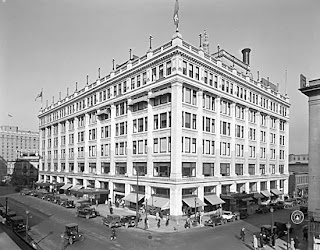
Anyone that has been to Copenhagen (and many other European cities) knows how great the pedestrian streets are. So many people walking and biking, sitting on patios and in cafes, such a great place for people watching. It's surprising that Vancouver doesn't have more streets like this, seeing as we are trying to become the world's greenest city. The redesigned Granville Street will go along way in starting such a movement here, but I think we need to look longer term. This is what I see as a future car-free network in downtown (in blue):
 These routes are already great pedestrian streets in Vancouver - Robson, Davie, Denman and Granville. So great, in fact, that at times there is not enough room for all the people walking along it. Think of Robson on a warm sunny weekend day - people are bumping into each other making their way along. It only makes sense to take advantage of this fact, and give pedestrians more room to move. Let's face it, no one drives along Robson Street to actually get anywhere - so let's start a gradual transition to remove the cars.
These routes are already great pedestrian streets in Vancouver - Robson, Davie, Denman and Granville. So great, in fact, that at times there is not enough room for all the people walking along it. Think of Robson on a warm sunny weekend day - people are bumping into each other making their way along. It only makes sense to take advantage of this fact, and give pedestrians more room to move. Let's face it, no one drives along Robson Street to actually get anywhere - so let's start a gradual transition to remove the cars.I'm not saying that overnight we should shut the street down to cars. Doing that would leave us with what Granville Street was up until recently - a dead zone. Instead, like they did in Copenhagen, the closure should be very gradual.

1. Start by giving more space to pedestrians where it makes sense: at bus stops, intersections, mid-block crossings on longer blocks, and anywhere pedestrians always seem to bunch up. Many of these ideas were recently incorporated into a redesign of Main Street. This could also be considered a sort of traffic calming.

2.Then start taking away on-street parking spots, just a few percent each year. So few are taken that drivers don't even notice. Take those spots and turn them into pedestrian space.

3. Close a block here and there. Maybe only one or two each year, starting with those that make obvious sense. For example, at Robson Square, which is very narrow already. This gives drivers time to adapt to new routes, and eliminates major traffic issues. It also allows the city to deal with problems gradually, should they arise.

4. Over the course of about 20 years, a network of car-free routes forms, meaning people can walk or bike right in the city without cars in their way. Streetcars also work well into this plan, and could run along the centre of the streets.

In Vancouver, the obvious place to start is Robson Street. The section between Bute and Granville, in particular, is a perfect candidate for "pedestrianization". Start with bus and pedestrian bulges, and remove a few parking spaces at key points to widen the sidewalk (in front of Cafe Crepe near Burrard, for example). A "scramble crossing" at Burrard and Robson would make pedestrian crossing easier and move traffic more effectively.

Next, move onto Davie and Denman - the sidewalks on these streets are just too narrow for the number of people walking along most sections. Eventually join all four streets to form a network of pedestrian streets and over time close them off to cars. It may take 20-30 years, but other cities have proven it works and with great results.













